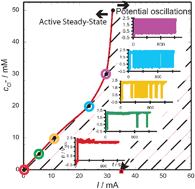Temporal patterning of the potential induced by localized corrosion of iron passivity in acid media. Growth and breakdown of the oxide film described in terms of a point defect model
Abstract
This work analyses the nature of temporal patterning of the anodic potential induced by chlorides during polarization of iron under current-controlled conditions in acid solutions. It is shown that potential oscillations emerged as a result of the local chloride attack of a thin oxide layer, which covers the iron surface in its passive state. The mechanism by which both the local oxide breakdown and the subsequent localized active dissolution (pitting) occur is explained by considering a point defect model (PDM) developed to describe the oxide growth and breakdown. According to the PDM, chlorides occupy oxygen vacancies resulting in the inhibition of oxide growth and autocatalytic generation of cation vacancies that destabilize the oxide layer. Simultaneous transformation of the outer surface of the inner oxide layer to non-adherent ferrous chloride or oxo-chloride species leads to a further thinning of the oxide layer and its lifting-on from the iron surface. The process repeats again yielding sustained oscillations of the anodic potential. Analysis of the oscillatory response obtained under current-controlled conditions as a function of either the current or the time allows the suggestion of a set of alternate diagnostic criteria, which might be used to characterize localized corrosion of iron in acid solutions.


 Please wait while we load your content...
Please wait while we load your content...